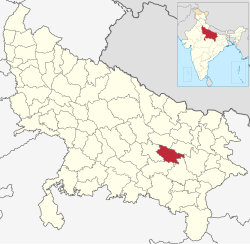Sultanpur district
|
Sultanpur district सुलतानपुर जनपद سلطانپور ضلع |
|
|---|---|
| District of Uttar Pradesh | |
 Location of Sultanpur district in Uttar Pradesh |
|
| Country | India |
| State | Uttar Pradesh |
| Administrative division | Faizabad |
| Headquarters | Sultanpur, Uttar Pradesh |
| Tehsils | Lambhua, Kadipur, Sultanpur, Jaisinghpur, Baldirai (Newly Formed) |
| Government | |
| • Lok Sabha constituencies | Sultanpur |
| • Assembly seats | 5 |
| Area | |
| • Total | 4,436 km2 (1,713 sq mi) |
| Population (2011) | |
| • Total | 3,790,922 |
| • Density | 850/km2 (2,200/sq mi) |
| Demographics | |
| • Literacy | 71.14 |
| • Sex ratio | 1.5 |
| Website | Official website |
Sultanpur district is a district in the state of Uttar Pradesh in northern India. The district is a part of Faizabad Division. Its administrative headquarters is Sultanpur. There are many historical place in Sultanpur like Vijethua (Mahaviran), Dhopap, Sitakund Ghaat & more. Agricultural is the prime resource for livelihood of people.
Around the 14-15th century, Rajkunwar branch of Chauhan Dynasty claiming to be direct descendent of Hammir Dev Chauhan of Ranthambore along with other clans like Bandalgotis, Rajwars and Bachgotis ruled over a large part of the district. In the 19th century, one notable incident was the revolt of the native troops stationed at Sultanpur during the Sepoy Mutiny after the British annexation of Oudh. The troops rose in rebellion on 9 June 1857, and, after murdering two of their officers, sacked the station. Native people and tribes like that of Bhale Sultans also fought in the rebellion. Leaders like Lal Pratap Singh of Kalakankar and Maharaj Bariar Singh Rajkunwar along with others fought and died for the cause. Upon the restoration of order, Sultanpur cantonment was strengthened by a detachment of British troops; but in 1861 it was entirely abandoned as a military station.
It has an area of 1,713 square miles (4,437 km2) . The surface is generally level, being broken only by ravines in the neighborhood of the rivers. The central portion is highly cultivated, while in the south are widespread arid plains and swampy jhils or marshes. The principal river is the Gomti River, which passes through the centre of the district and serves a valuable highway for commerce. Minor streams are the Kandu, Pili, Tengha and Nandhia; their channels form the outlet for the superfluous water of the jhils, draining into the Sai. Due to its plain fertile land and irrigation facilities, it has got an agricultural importance. Primarily an agricultural district, its principal crops are rice, pulses, wheat, barley, sugarcane and a little poppy.
...
Wikipedia
